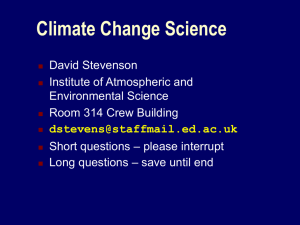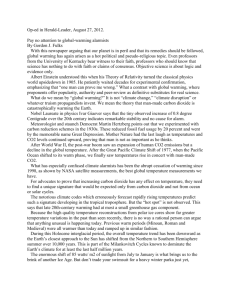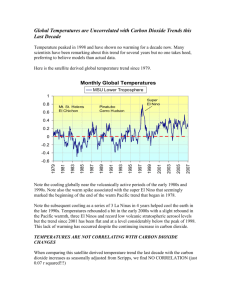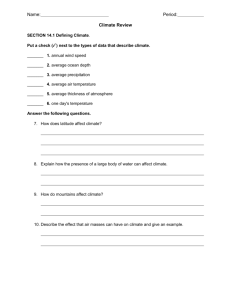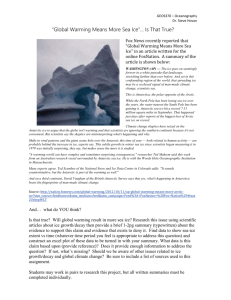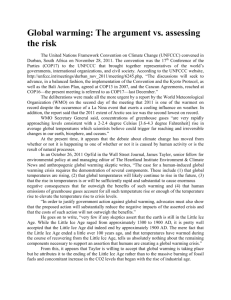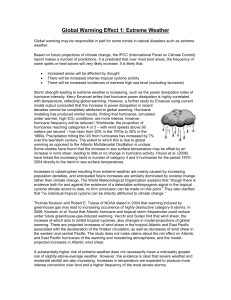GlobalWarming
advertisement
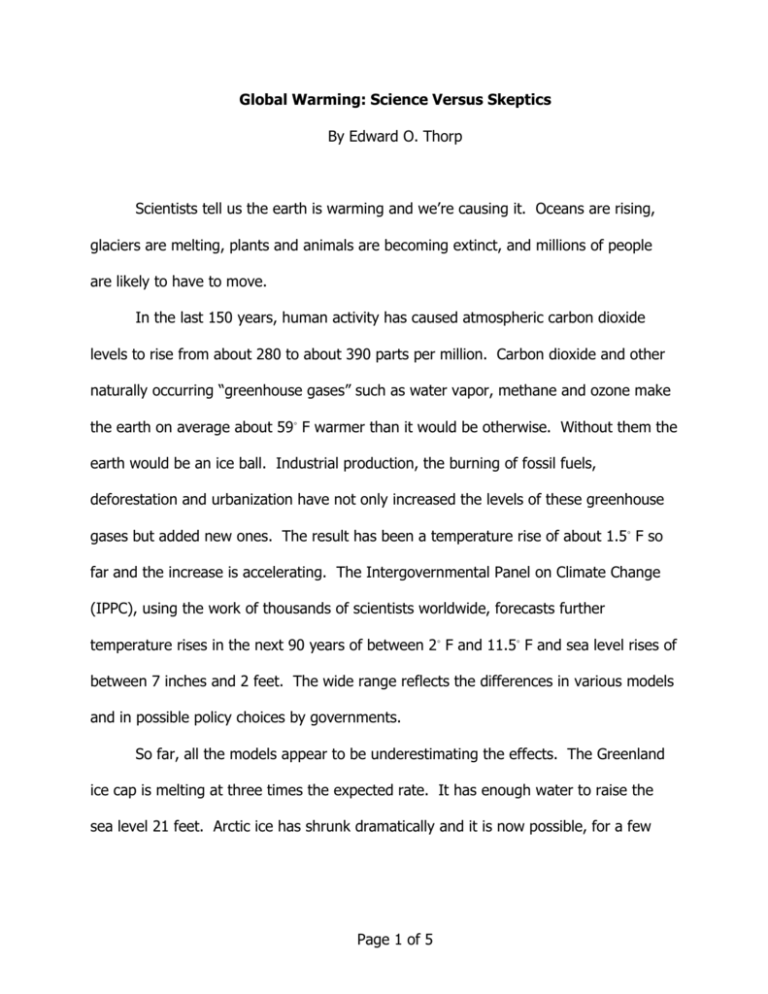
Global Warming: Science Versus Skeptics By Edward O. Thorp Scientists tell us the earth is warming and we’re causing it. Oceans are rising, glaciers are melting, plants and animals are becoming extinct, and millions of people are likely to have to move. In the last 150 years, human activity has caused atmospheric carbon dioxide levels to rise from about 280 to about 390 parts per million. Carbon dioxide and other naturally occurring “greenhouse gases” such as water vapor, methane and ozone make the earth on average about 59◦ F warmer than it would be otherwise. Without them the earth would be an ice ball. Industrial production, the burning of fossil fuels, deforestation and urbanization have not only increased the levels of these greenhouse gases but added new ones. The result has been a temperature rise of about 1.5◦ F so far and the increase is accelerating. The Intergovernmental Panel on Climate Change (IPPC), using the work of thousands of scientists worldwide, forecasts further temperature rises in the next 90 years of between 2◦ F and 11.5◦ F and sea level rises of between 7 inches and 2 feet. The wide range reflects the differences in various models and in possible policy choices by governments. So far, all the models appear to be underestimating the effects. The Greenland ice cap is melting at three times the expected rate. It has enough water to raise the sea level 21 feet. Arctic ice has shrunk dramatically and it is now possible, for a few Page 1 of 5 weeks in the summer, for ships to take a polar route along the northern Russian coast from Asia to Europe. Some skeptics think there is no heat-trapping effect from greenhouse gases. These are people who are ignorant of elementary science. Gases like carbon dioxide, methane and water vapor, by trapping some of the heat radiated from the earth’s surface, warm the earth much like a blanket would warm you if you were sitting outside on a cold day. The principles have been well understood since the nineteenth century. Doubters point out that there have been wide fluctuations in the earth’s temperature and in sea levels over the last several hundred million years. The causes include massive volcanic eruptions, asteroid impacts, the proliferation of plants, with their appetite for carbon dioxide, and geological processes that sometimes increase and sometimes decrease CO2 levels. Fluctuations in the sun’s radiation and variations in the earth’s orientation and orbit have also played a role. Worse has happened before. Why worry? What’s different now is that a once tiny human population of a few thousand hunter-gatherers could just walk somewhere else if they didn’t like the climate. Now almost seven billion of us have spread our civilization and its infrastructure over the planet. The dislocations from climate change can be costly and painful. Changes taking thousands or even millions of years don’t matter for this century. Also, these factors from past eons don’t explain the last century’s unusual warming, whereas it is explained by the scientific analysis of the amounts by which various factors have added to, or subtracted from, the recent increase in average global Page 2 of 5 temperatures. It’s spelled out in detail in the August 2007 Scientific American story, “The Undeniable Case for Global Warming”. The bottom line is that various natural effects have mostly offset each other and human activity explains the net increase. What about the claim that temperatures declined over the last decade? Although 2008 was relatively cool, the last decade was the hottest on record, and 2009 was another hot year. Worldwide, the eleven warmest years on record all occurred during the last thirteen years, 1997-2009. Skeptics here aren’t worried because the pattern for the U.S. is less strong. Though average annual temperatures have tended sharply upward, year-to-year numbers fluctuate and we can expect short downwards trends amidst an overall upward trend. A pause during the last decade is scant evidence against the upward trend. A chart of the S&P 500 stock index, which also has substantial year-to-year variation, shows similar behavior. The average price for the last decade was the highest ever recorded. But the all-time peak was 1498 on January 3, 2000, prices were lower at the end of the decade, 2008 was an unusually “cold” year for the market, and 2009 was another “hot” one. Ironically, several of the same skeptics who believe temperatures for last ten years rebut global warming continue to invest heavily in equities. A down decade in the market doesn’t alter their view that the long term trend is up! Skeptics find it baffling that, as the earth warms overall, some areas like the U.S. have been only mildly affected, so far. Portions of the Antarctic and Greenland have even cooled somewhat. This happens because wind and water redistribute the earth’s heat in a very complex and uneven way. Meanwhile, the Antarctic ice shelves are Page 3 of 5 breaking up and the glaciers, which are rivers of ice, speed ever faster into the sea. Icebergs are becoming more numerous near New Zealand. So far, the rise in ocean levels has been mainly due to the sea water expanding as it warms. However, the Antarctic holds enough ice to raise sea levels 120 feet. The science is clear and we’re seeing the impact of glaciers shrinking worldwide, sea levels rising and animals and plants moving towards the poles. Those who wave this away remind me of the man caught in flagrante delicto by his wife. Denying everything, he said, “Who are you going to believe, me or your lying eyes?” Why is there still so much public confusion? We’ve seen it all before. For decades skeptics denied that smoking caused lung cancer. Many people still deny that excess caloric consumption leads to obesity. After years of strident denying the scientific proof, the N.F.L. has finally admitted that the game-related concussions cause long-term brain damage in their players. F. Sherwood Rowland and Mario Molina of UCI explained in 1974 how CFCs (chlorofluorocarbons) depleted earth’s protective ozone layer. Companies who profited from CFCs continued to claim the science as unsound, despite overwhelming proof. Like climate change the details are complex. It takes some scientific background to sort through the claims and counter-claims, and economic interests are threatened. The earth has gotten markedly warmer in the last century. Human activity caused it. This will continue and the real issue is, what should we do about it, if anything? Should we “cap and trade” carbon? Subsidize forests in less-developed Page 4 of 5 countries? Promote clean energy sources? Tax carbon? Build more nuclear power plants? We need to understand the costs and benefits of these and other ideas so we can choose wisely. Here is where we in the business community, using our knowledge and experience to act in the public interest, can literally change the world. Thorp is president of Edward O. Thorp & Associates, author of Beat the Dealer and Beat the Market, and is Professor Emeritus of Mathematics and Finance at U.C.I. Page 5 of 5
